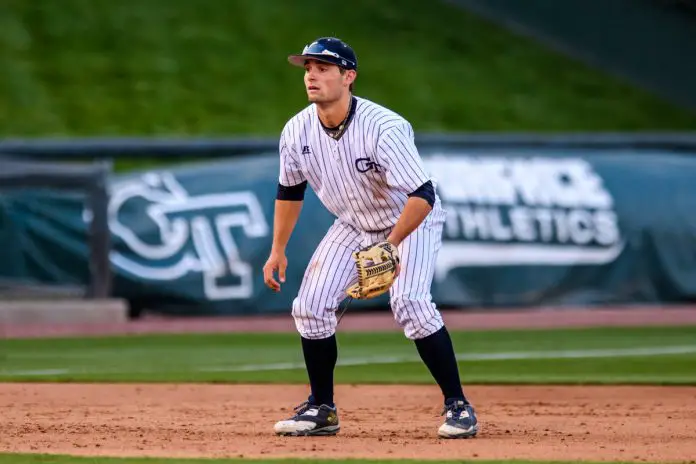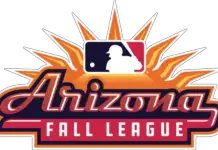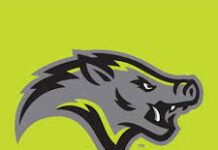Welcome to the second installment of my countdown of the Orioles Top 50 Prospects for 2018. If you missed prospects #41-50 and my introduction, check it out here.
#31-40
Rank – Name – Position – Highest Level – Age on opening day 2018
Tier 6 – Future Value 35
#40 – Jacob Brown – LF/RF/CF – Rookie – 19
Drafted in the 18th round of the 2017 draft, Brown is a raw, undersized but toolsy HS outfielder. He generates surprising power for a player his age and size. I didn’t get to see him much (played in the GCL), so I’ll direct you all to a quality in person report from Baseball Census (who I highly recommend).
#39 – Steve Wilkerson – 2B/3B/Utility – AA – 26
Wilkerson was a senior sign draftee out of Clemson back in 2014 and has been gradually making his way through the system. The switch-hitter seems to have matured into some fringy pull power. He has a clean line drive swing and average bat speed from both sides of the plate, so it’s likely he’ll continue to make contact going forward. The main question for his bat is whether he’ll hit for enough power to maintain a solid BB rate against MLB pitching. It seems unlikely. Plays solid defense at 2B, and is OK at 3B as well. Played some SS during a strong Arizona Fall League performance, but you probably don’t want to play him there much. Utility profile if he hits for enough pop to keep pitchers honest. Will begin 2018 on a 50 game suspension for amphetamines.
#38 – Drew Dosch – 3B – AAA – 25
Dosch is another guy who has climbed slowly though the Orioles system, he’s been decent at every level but hasn’t stood out. He has a nice LH uppercut swing, like Chance Sisco with less bat speed. Does a good job of getting the ball in the air but doesn’t have enough raw power to take full advantage of it. He may be a guy who’d benefit from the way the MLB ball has been flying the past couple years. He’s alright at 3B, he’s not a butcher, but I’d say he’s below MLB average. I’d like to see him get some reps at other positions (COF, 2B) because he hits RHP well and may be able to find a MLB role as a versatile platoon bat.
#37 – Pedro Araujo – RHP – A+ (couple of AA innings) – 24
Rule 5 draft pick from the Cubs. Smooth arm action, stays closed and hides the ball which creates deception. Low 90s fastball, some run, but nothing special. He throws a curveball that I’ve heard people put a plus-plus grade on. I wouldn’t go that far, I think it’s plus. He has some command issues that likely stem from a rough and inconsistent landing on his front foot. He actually commands the curve better than the fastball at this point. Great results in A+ ball, but old for the level, will likely struggle against advanced hitters without a command improvement. Unlikely to stick with the Orioles IMO, middle relief profile with some limited upside.
Tier 5 – Future Value 40
#36 – Yefry Ramirez – RHP – AA – 24
Converted infielder with a long but easy arm action. Stays closed but falls off hard to the 1B side with a cross-body finish. This limits command and consistency, but appears to add enough deception to allow his flat, low 90s fastball to play. Feel for slider and changeup come and go, can be above average at times, fringe average at others. Good competitor on the mound, good feel for pitching, manages to keep the ball off the barrel. He’s an extreme FB pitcher though, home runs could be an issue. Middle relief profile, could be a #5 starter if the command takes a big step.
#35 – Austin Wynns – C – AA (couple of AAA games) – 27
Recently added to the 40 man roster. Good defensive catcher, as MLB-ready as he’s going to be. Plus blocker, good receiver, above average catch and throw. Broke out at the plate in 2017, buoyed by a 12% BB rate. At 26 years old, he was quite old for the level, so his stats need to be taken with a grain of salt. The swing is simple, choppy with below average bat speed. Shows an advanced approach and good pitch recognition. Has some strength, but doesn’t get the ball in the air enough to use it. BB rate will likely suffer in MLB without the power to kept pitchers honest. Defensive-minded back-up catcher profile.
#34 – Ofelky Peralta – RHP – A+ – 20
Peralta has been inexplicably moved aggressively through the O’s system, so he’s been young for the level at every stop. He’s a tall, lean right handed pitcher with a long arm action and some effort to the delivery. Doesn’t repeat the delivery well, the release point and landing are all over the place. He features a legit plus-plus fastball. It sits in the upper 90s and features significant armside run. His curveball and changeup lag far behind. He has no idea where the secondaries are going and they are extremely inconsistent in quality. Both are well below average pitches currently. He’s still young and his projectable frame has room for more growth. He could take steps forward as he matures, but a move to the bullpen is necessary in my opinion.
#33 – Trevor Craport – 3B/1B/C? – short season – 21 (pictured)
The Orioles 11th round draft pick in 2017, Craport was one of the best hitters in the NY/Penn league. He has a patient approach, very little swing and miss. Extremely pull-happy, tries to pull everything. It works for him though because it allows his fringe power to play up a bit and it doesn’t seem to hurt his contact ability at this point. He has a late load and a little bat wrap that could probably be smoothed out. Not a great 3B, but his play improved over the course of the season and he has enough arm for it. He needs to stick at 3B for the bat to profile. There is at least some interest at trying him at catcher.
#32 – David Hess – RHP – AA – 24
A stocky athletically-built righty, Hess offers a 4 pitch repertoire. He has a high effort delivery with an exaggerated arm stab. He gets good drive with his lower half which helps him hold his stuff late into outings. His fastball is his best pitch and is easily plus. It sits 92-94, and can touch 96 with late life. He has average command of the pitch and it misses plenty of bats. He throws a tight slider with plus movement, but he is very inconsistent with the pitch and has little command of it. His curveball ranges in quality, sometimes he doesn’t finish the pitch, but it’s an above average pitch when on. The curve is the most consistent of his secondary pitches. He can throw it for strikes but can’t really move it around. It’s more of a weak contact pitch than an out pitch. The changeup is poor and he has little feel for it. Later in the year when he was most successful, he was mostly a fastball/curveball pitcher. I don’t know if that’ll play as a starter against MLB hitters. I’d like to see him in a relief role where he can dial his fastball up into the upper 90s and pick one breaking ball. He has late inning relief upside.
#31 – John Means – LHP – AA – 24
A tall, lean lefty, Means has an easy high 3/4 delivery. He works fast on the mound and offers a 3 pitch mix. The fastball sits 91-92 and can touch 94. It is pretty flat but he can move it around some. His best pitch in my opinion is his above average deceptive changeup, it looks like a fastball out of his hand but has a good velocity gap and backs up armside. He also throws a fringe average curveball that works on lefties but isn’t sharp enough to play against righties. He has above average to plus control, his command is a step behind and can get away from him when he’s struggling. The stuff isn’t going to wow anyone, but I think he can eat innings as a 5th starter/swingman. I think the stuff could play up in a relief role if he’s just too hittable as a starter.
Check out prospects #21-30 here.
See prospects #11-20 here.
Discuss here.

























